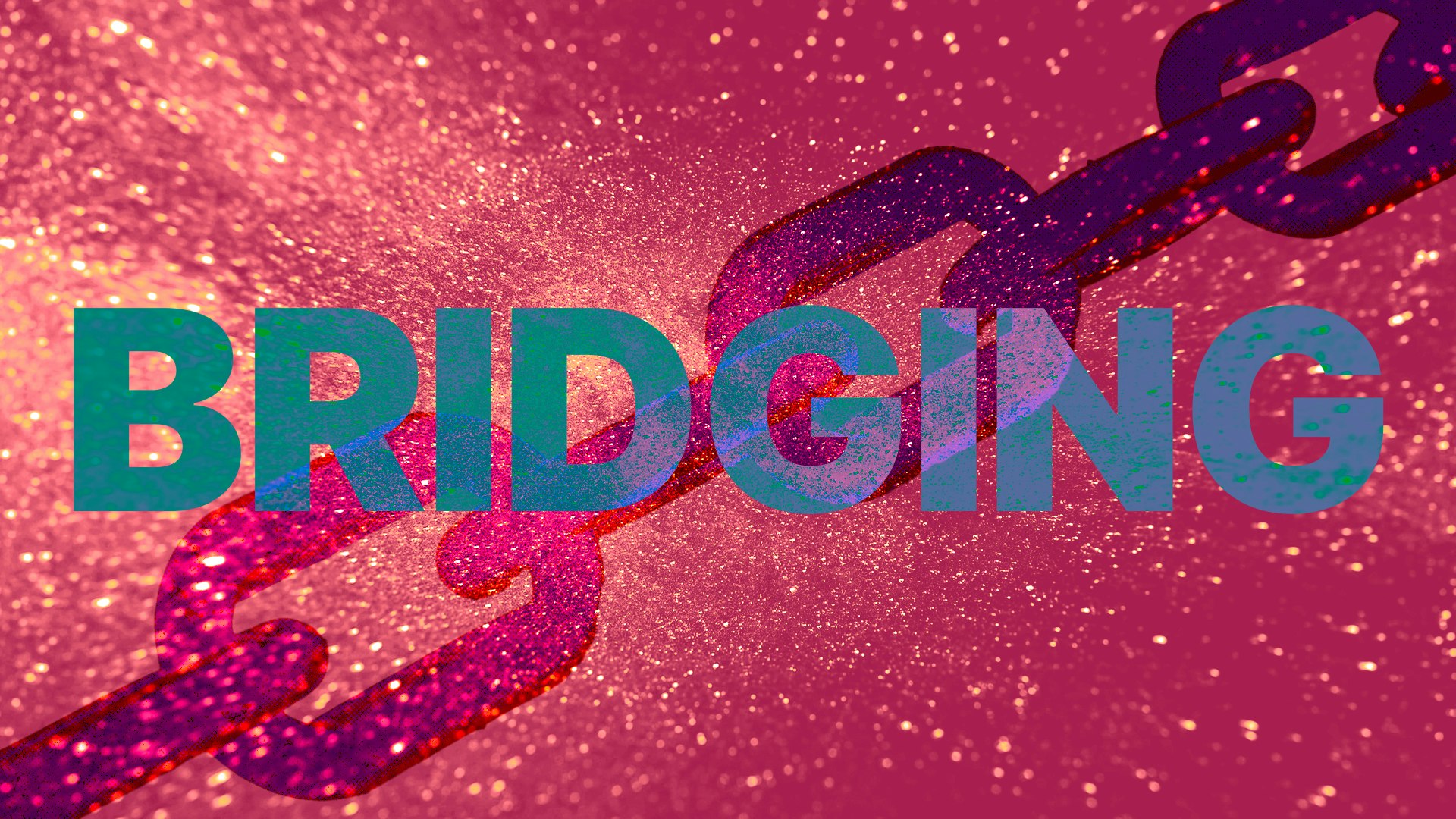Don’t invest unless you’re prepared to lose all the money you invest. This is a high‑risk investment and you should not expect to be protected if something goes wrong.
Multichain: What is a Bridge in Crypto? Bridging Explained
What is a bridge in crypto? As the interaction between different blockchains grows, this is everything you need to know.
In this article...
- Connect different blockchain ecosystems.
- Transfer assets between blockchains.
- Unlock the potential of cross-chain solutions.

Bridging is an evolving technology in crypto. But what is a bridge in crypto? A "bridge" is the connection between different blockchain networks that can’t work together without it.
So let’s dig into the concept of crypto bridges, and the role they play in the future of decentralised finance (DeFi).
Understanding a crypto bridge
A bridge (or a cross-chain connector) in the crypto world enables the transfer of assets and data between two or more distinct blockchains.
Before the bridge was enabled, these blockchains operated independently. This means that their users could not move assets across chains before the cross-chain connector was put in place.
After the bridge is in place, this makes it much more convenient for the user, as the blockchains can work together. It acts as a pathway, allowing users to move tokens, smart contracts, and other information across these otherwise separate networks.
Example: Ethereum and Polygon
Ethereum, being the more established blockchain, has a larger user base and a large ecosystem of decentralised applications (dApps). However, it also suffers from network congestion, particularly during periods of high activity. This means the fees charged to use it (called gas fees) rise when the network is in demand. So at times it can get inefficient and be uncompetitively priced.
Polygon, on the other hand, is a blockchain that works alongside Ethereum. It is called a layer-2 scaling solution for Ethereum. Ethereum Mainnet is the first layer, Polygon is the second layer. Polygon was developed to make Ethereum efficient and aim for competitive transactions.
The Polygon Bridge
The Polygon Bridge allows users to transfer assets between Ethereum and Polygon. This is achieved by locking the original asset on the Ethereum blockchain and creating a representation of that asset on the Polygon blockchain. When the user wishes to move the asset back to Ethereum, the representation on Polygon is burned, and the original asset on Ethereum is unlocked.
Advantages
Users can interact with Ethereum dApps using Polygon, taking advantage of Polygon's significantly more competitive gas fees and efficient transaction speeds. This makes using Ethereum-based dApps more accessible and cost-effective, particularly for microtransactions or frequent interactions.
Developers can deploy their dApps (apps built on the blockchain rather than the internet) on Polygon, tapping into its growing user base.
And, by bridging assets between Ethereum and Polygon, the liquidity of those assets can be increased across both blockchains. This can benefit traders and investors by providing more opportunities for buying and selling assets.

How do crypto bridges work?
The inner workings of a crypto bridge can differ based on its design and the specific blockchains involved. However, most bridges use a combination of smart contracts, locking mechanisms, and minting processes.
Locking and minting
When a user wants to transfer an asset from one blockchain (Chain A) to another (Chain B), the asset is first "locked" in a smart contract on Chain A. The bridge then "mints" a corresponding wrapped token or a representation of the original asset on Chain B. This wrapped token is designed to maintain a 1:1 peg with the original asset and can be used freely on Chain B.
Cross-chain communication
Some bridges facilitate more complex interactions between blockchains, allowing them to exchange data and execute smart contracts across networks. This enables the development of cross-chain dApps and interoperability between different ecosystems.
Benefits of crypto bridges
Crypto bridges contribute to the overall growth and efficiency of the blockchain space.
Bridges break down the barriers between blockchains, allowing for greater collaboration, data sharing, and the seamless movement of assets. By enabling asset transfers, cross-chain connectors can increase liquidity across various blockchain networks, making it convenient for users to access and trade different tokens.
Cross-chain connectors can alleviate congestion on a particular blockchain by facilitating the movement of transactions to other, less congested networks. Cross-chain communication and interoperability helps developers to create novel dApps and explore new things in DeFi.
Risks
Unfortunately, with cross-chain connectors come the risks of any technology: Hacks.
The biggest ever bridge hack was the in March 2022. Hackers exploited vulnerabilities in the Ronin Network, an Ethereum sidechain used by the popular game Axie Infinity, and stole approximately US$625 million worth of cryptocurrency.
Also, some cross-chain connectors may rely on a centralised entity that runs it which can be seen as against the decentralised ethos of blockchain.
##Bridges in blockchain: Conclusion
Cross-chain connectors connect separate blockchain networks and unlock the full potential of decentralised finance.

Frequently asked questions
What is a bridge in the context of crypto and blockchain technology?
A cross-chain connector enables the transfer of digital assets like cryptocurrencies between different blockchains, such as moving tokens from the Ethereum network to the Bitcoin network. It eliminates the need for a trusted third party, fostering peer-to-peer transactions.
Why are cross-chain connectors important in the world of crypto assets?
Different blockchains operate with distinct rules and protocols, making it challenging to move assets between them directly. Cross-chain connectors solve this, enabling greater interoperability and expanding the use cases for various cryptocurrencies.
How do decentralized bridges contribute to blockchain protection?
They distribute the responsibility of validating transactions across a network of nodes, reducing the risk of a single point of failure. This enhances protection compared to traditional, centralised systems. However, of course, they can also be a chink in the armour, and have been hacked before.
Are there different types of blockchain bridges?
Yes, there are various types, including those designed for public blockchains like Ethereum and others tailored for permissioned blockchains used in specific industries like supply chain management.
What role does computing power play in bridge operations?
Cross-chain connectors often rely on nodes with significant computing power to validate and process transactions, ensuring the smooth and protected transfer of digital assets across blockchains.
What are the benefits of using bridges for users?
Cross-chain connectors unlock access to a wider range of crypto assets and decentralized applications (dApps) across different blockchains. Many modern cross-chain connectors prioritise user-friendly interfaces, making them accessible to a broader audience. However, for newbies they can still be complicated to use.
Bottom line: Why should investors care about bridges in crypto?
A cross-chain connector is essential for the continued growth and interconnectivity of the crypto ecosystem. They promote greater protection, accessibility, and flexibility in managing digital assets across various blockchains.

Suggested Articles
What is Bitcoin (BTC)? What is "Digital Gold" Used For?
What is Bitcoin? It is a digital currency that can be traded, exchanged, and used as a form of payment independent of central banks and governments.What is Ethereum? What is ETH Used For?
Ethereum is a decentralised blockchain-based open-source software platform that allows for the development of decentralised applications (dApps).What Is Crypto? How do Cryptocurrencies Work?
Crypto has become incredibly popular. But how does this digital currency work? And are there cryptos other than Bitcoin?Browse by topic





Cryptoassets traded on CoinJar UK Limited are largely unregulated in the UK, and you are unable to access the Financial Service Compensation Scheme or the Financial Ombudsman Service.
We use third party banking, safekeeping and payment providers, and the failure of any of these providers could also lead to a loss of your assets. We recommend you obtain financial advice before making a decision to use your credit card to purchase cryptoassets or to invest in cryptoassets. Capital Gains Tax may be payable on profits.
CoinJar’s digital currency exchange services are operated in the UK by CoinJar UK Limited (company number 8905988), registered by the Financial Conduct Authority as a Cryptoasset Exchange Provider and Custodian Wallet Provider in the United Kingdom under the Money Laundering, Terrorist Financing and Transfer of Funds (Information on the Payer) Regulations 2017, as amended (Firm Reference No. 928767).
Apple Pay and Apple Watch are trademarks of Apple Inc. Google Pay is a trademark of Google LLC.
This site is protected by reCAPTCHA and the and apply.